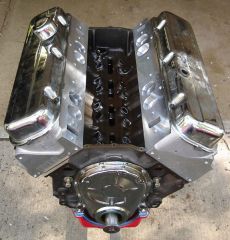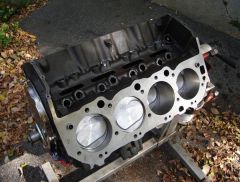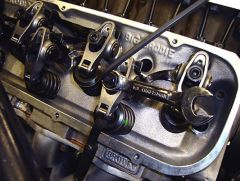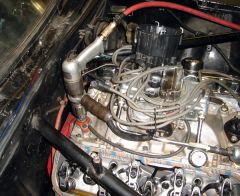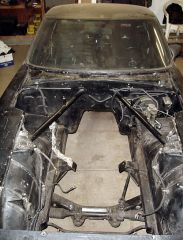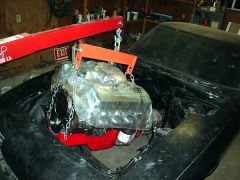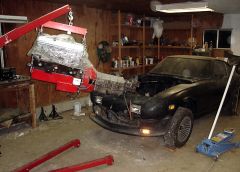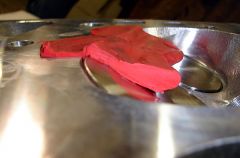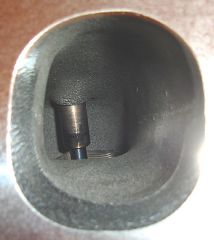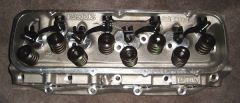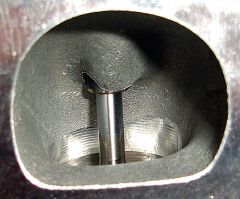-
Posts
825 -
Joined
-
Last visited
-
Days Won
7
Content Type
Profiles
Forums
Blogs
Events
Gallery
Downloads
Store
Everything posted by Michael
-
Curiously, as circumstances now appear to stand, if the car's owner is somehow too frightened to sue, or just does not know how to get the process going, he's out of luck. And even if he does sue, after lawyer's fees and the strain of legal proceedings take their toll, perhaps he would end up losing more than what he paid for the car. Gotta love "the system"!
-
Externally that Nissan SE-R resembles the 1992 1.6L Sentra that I bought recently... only mine would be lucky to run the 1/4 mile in under 20 seconds. With the air conditioning running, it is unable to exceed 90 mph on a straight level road.
-
Some one replied to my post from 6 years ago? Wow! - I don't quite know what to say....
-
Experience shows that the swap contains too challenges: getting the engine and transmission to work, and doing the swap itself. I mean, mounting the engine, doing the cooling and exhaust, connecting the driveshaft, wiring the electricals and fuel pump, etc., is “the swap”. But if your engine is wounded then you’ll be doing engine work quite unrelated to the swap per se - and this could be considerably more frustrating and time consuming that the swap itself! So the best option, as reiterated in the JTR book, is to score a well-running donor car. It really doesn’t matter if it’s a 70’s Caprice with a old-school carb’d 350, or a mid 90’s Z28 Camaro with a LT1 - as long as the thing runs. If the donor car is relatively quick, the Z will be very quick. But if the donor car pukes smoke, burns oil and runs 19’s in the quarter mile, the Z will run maybe 15’s - which defeats the point of doing a swap. I would have to differ from some of the above posts, in that there’s something emotionally unfulfilling in using a 305 instead of a 350. Unfortunately 350’s have become much more scarce since the JTR manual first hit the market, around 8 years ago. So perhaps a worthwhile option is a 80’s-90’s Chevy or GMC pickup truck with a 350. Often these come with a 700R4 transmission, and they may be relatively easy to find at auctions - for example, retired city maintenance vehicles. A manual transmission with a Gen I 350 seems to be quite rare. Most manual-transmission Camaros and Firebirds had 305s; the 1989 Firebird that you found is almost certainly a 305. Personally I dislike automatics, but I would rather get a 350 with a slushbox than a 305 with a T5 manual, and would look for an early 1990’s Chevy pickup with a TBI 350 and 700R4.
-
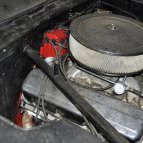
I thought you guys might like this..
Michael replied to grumpyvette's topic in Gen I & II Chevy V8 Tech Board
0.712” lift in a SBC is HUGE! I have to wonder - if they went with a shaft rocker system and a commensurately race-oriented valvetrain, why did they not use aluminum heads, and why did they limit themselves to 385 cubic inches? This engine could evidently get decent volumetric efficiency even approaching 7000 rpm - but at that point, would the bottom end still be reliable? -
I had a 1987 MKIII Supra. Some people swear by these cars, but it wasn’t my type at all: heavy, ponderous, and with obnoxiously annoying turbo lag. Oh yeah, and the head gasket blew twice. They are, however, quite comfortable and very stable in high-speed cruising, but that’s not my driving style. The car that I really miss is my 1983 Celica - it was the first generation to have reliable fuel injection, and the last generation still with RWD. It was a bit boxy, but reasonably light (about 2600 lbs, if I’m not mistaken) despite being quite roomy. A really cool swap would have been some sort of V8 (such as 302 Ford) into the 1983-1985 Celica. Some pictures of a similarly-equipped drag Celica were floating around a few years ago.
-
Agreed that this heat is miserable, especially when air conditioning at the office breaks down! But also agreed that it’s nowhere near as unpleasant as the winter freeze. Last year right before Christmas we got >12” of snow, followed by sub-zero nights and 10-deg days. It’s almost 400’ from my garage to the road, and digging that by hand took me most of one night, the entire following day, and the next evening. We ran out of clean drinking water (it is unsafe to drink our tap water, as it comes from a questionable well), and quite literally had to gather snow in buckets and boil it. Summer might be especially hot in the city, but winter is especially miserable in the countryside! Every time I catch myself cursing the heat, I shudder to contemplate the coming snows.
-
I seem to have lost motivation right after the car was “done”; drove it a total of 2.0 miles (as registered by the odometer) in three segments, mostly up and down my driveway. It’s really hard to shift, the engine smokes profusely, and who knows what sorts of horrors await me at the dyno shop, where I intend to take the car for diagnosis. Eventually I realized that it is simply impractical to drive this car on the street; I need a tow rig and trailer. Besides, I would rather have a “running” car sitting in my garage, than banging on it, only to render it into a pile of broken parts.
-
In my view there is much to be said for the achievement value and camaraderie of working together on a group HybridZ car. The more experienced folks would help the younger ones. The theoreticians and the practitioners would find some happy medium. The road racers would dip into drag racing, and vice versa. But what is the justification for “promoting the Z car experience”? What do we gain from popularizing Z-cars, Hybrid or otherwise? Do we need expanded endorsement and attention to feel better about our cars? Would we like to get more “respect” at car shows and race tracks? Do we wish to reverse the condescending treatment in Hot Rod Magazine? Would we hope to get discounts on parts, or more model-specific aftermarket support? I’m very interested in participating in a group build, but the objective is to meet more fellow enthusiasts in person and to learn from their experience - and maybe to share a bit of my own “experience” - and NOT to somehow increase visibility or engage in an advertising campaign. This is why it makes sense to have several HybridZ cars under construction concurrently, in different parts of the country; one in NorCal, one in SoCal, one in Texas, one in Florida, one in the Mid-Atlantic region, one in the Midwest, and so forth. I would like to be with a few hours’ drive of the build site; and in fact, the build site could rotate amongst several different garages. Such cars would NOT be built over a few months, then raced and retired. They would evolve over many years, chronicling lessons-learned and building a real-life FAQ list.
-
For a rotational system, power is torque times angular speed. The power dissipated in spinning a transmission comes from two parts: that necessary to change the rpm (when accelerating), and that needed to maintain a steady rpm. The former goes as moment of inertia times rate of angular acceleration times angular speed. This is where spinning “big stuff” takes more power. The latter goes as force (as in friction) “times” (actually cross product) a moment arm times angular speed. A transmission with lots of big, heavy parts (technical terms here!) does not necessarily absorb lots of power when maintaining a constant rpm, but it will absorb lots of power to spool-up. Whereas a transmission with "light" parts might nevertheless absorb lots of power in cruise, if it has a lot of internal friction acting between surfaces at high relative rotational rates.
-
This is one of those open-ended questions that tend to rile people, as (1) it has been asked frequently before, and (2) the answer depends completely on the scope of your project, the initial condition of your car, and the extent of your hot-rodding experience. An experienced mechanic starting with solid, rust-“free” car and a complete set of parts could complete the swap over a weekend. An inexperienced non-mechanic with a worn-out car and an incomplete/mismatched set of parts won’t complete the swap even in one year. Some people are now into their second decade.
-

Starting My 454 BBC Install.....(pics)
Michael replied to Cable's topic in Gen I & II Chevy V8 Tech Board
If you used the JTR mounts, which offset the engine towards the passenger side, header/frame rail interference is almost certainly unavoidable; be prepared to notch the frame rail and weld in a patch. -
This reminds me of the thread about whether people work on their Z alone or in the company of friends/advisors. There the preponderance of comments were in the “alone” column. And in this thread, most folks are posting that they are the ones providing the tools and being the neighborhood automotive resource. Whereas I tend to be the guy who appeals to acquaintances to borrow tools, to weld something for me, to come clean my gutters, etc. Maybe this is why it took so long to get my Z built, and why it’s still no really finished? Then it dawned on me… at work, I tell graduate students, technicians and the like to wire such-and-such device, to calibrate so-and-so instrument, to run various tests, do different derivations, plot this and that - but I don’t do any of that myself! Instead, I go to meetings, review proposals, chair sessions at conferences and write research topic descriptions. In other words, I’ve become a manager! I am now officially incompetent and obnoxious!
-

Where the hell is a 350 in this town?!
Michael replied to lithium4750's topic in Gen I & II Chevy V8 Tech Board
This brings up an excellent point: not all of us are comfortable with E-bay or other internet-based long distance purchases. There is something to be said for visiting a junkyard within driving distance and finding a usable engine - if only a core. This shouldn’t be hard for something as common as the 350 SBC! For a number of reasons this option is in decline. Junkyards are closing down, while internet "commerce" is pulling the rug out from traditional in-person sales. When I lived in the Los Angeles area I relied on the “Recycler” newspaper, or its web site; the latter combined internet reach and immediacy, with local convenience. Anyway, back to the original question… consider buying a 1970’s-1980’s Chevy truck with a 350; these remain relatively plentiful, while full-size automobiles of similar vintage are becoming rare, and in the vast majority have 305’s instead of 350’s. Or, if you plan on a complete rebuild with heavy reliance on aftermarket parts, perhaps local machine shops already have bare blocks. -

Starting My 454 BBC Install.....(pics)
Michael replied to Cable's topic in Gen I & II Chevy V8 Tech Board
Project_BBZ, congratulations on the resumption of work on your Z! But why the 049 heads? Didn’t you sink plenty of labor into cleaning-up those Pro Toplines? It is highly unlikely that even professionally ported 049’s would flow comparably to the Pro Toplines. But perhaps your new combo is more conservative and the aftermarket heads would be of minor additional benefit… My big block Z now runs - well, to some extent. First oil change revealed no cause for alarm regarding possible bearing/rod/cam lobe problems, but I’m still worried. In fact, I’m so petrified that I would rather have a functional car sit forlorn in my garage, than risk damaging it by driving it - which, I suppose, negates the whole point of building the car… Anyway, be patient at this stage of the build; it would be most disconcerting to rush through the final details, only to discover a $4000 mistake upon break-in. -
Mike, I missed your bash, but congrats on that birthday! Now that you have some acreage you can relate to the hassle of taking care of so much land...
-

are you going it alone or do you have help
Michael replied to grumpyvette's topic in Gen I & II Chevy V8 Tech Board
This is going to sound utterly ridiculous, but wouldn't it be great to have something analogous to "personal ads" in newspapers, but rather for people interested in joining groups to work on cars? A common theme in this and similar threads seems to be: "when I was in high school/college/growing up/single/etc. my dad/uncle/buddies/neighbor/etc. and I would work together on cars, but now with a wife/kids/mortage/career I'm (a) too busy, ( friends are too busy, and © everyone has moved on". Well, when I was in high school/college/grad school I was working my butt off studying. All that I did was study; there was no time for cars. Now that I'm an "adult" - mid 30's, house with garage, plenty of money and actually plenty of time - everyone is gone! It's quite disconcerting to be so out of phase. -

HELP... Whats my best carb choice?
Michael replied to Nealio240z's topic in Gen I & II Chevy V8 Tech Board
Calculators can be very useful for giving an initial baseline, but the mere presence of specific numbers should not be conflated with good accuracy. There are simply too many variables to get much beyond just a rule of thumb. As an example, by most calculators my application seems to call for a 750 cfm carb, but with more specific advice this appears to be a huge underestimate. Off to the dyno in a couple of weeks (maybe...) to verify. -
Another consideration is that if you are interested in experimenting with parts' fit - especially with new or speculative combinations - it's much cheaper and easier to use junkyard parts. For example, I confirmed a friend's advice about trying a Gen II Camaro (1970-1982) front rotors on a 240Z, but grabbing the rotors from one such Camaro at the junkyard, and trying them on a Z. It turns out that they fit quite nicely; the only ambiguity is what to do with the grease seal.
-

Carb'd LS2 - 240Z on the way!
Michael replied to Pop N Wood's topic in Gen III & IV Chevy V8Z Tech Board
Should be a good combo! For new all-aluminum V8's, the LSX crate motor is hard to beat. And for simplicity, the carb is hard to argue with. -

URGHHH….Stupid C6 Corvette Driver….Cutting In & Out Of Traffic
Michael replied to slownrusty's topic in Non Tech Board
... the only problem is, that what reasonable people might consider to be idiotic behavior is not necessarily illegal behavior, and vice versa. But this is straying dangerously close to a political discussion.... -
It's a Mark IV big block Chevy, originally from a 1978 Suburban, though the only parts retained are the block, rods, crank, alternator and distributor body. 460 cubic inches come from 454 + 0.030" overbore. Like all pre-1990 (or thereabouts) Chevy V8's, the limiting factor for maximal engine setback is the distributor/firewall interference. In my case this problem was "solved" by setting back the firewall itself. BTW there is a fellow on HybridZ with a 460 big block Ford conversion in progress.
-
Photo album updated with engine install and detail pics. BTW, the strut tower brace is a welded custom job. Should be plenty strong, but makes valve cover removal a most unpleasant experience.
-
From the album: engine details and installation

